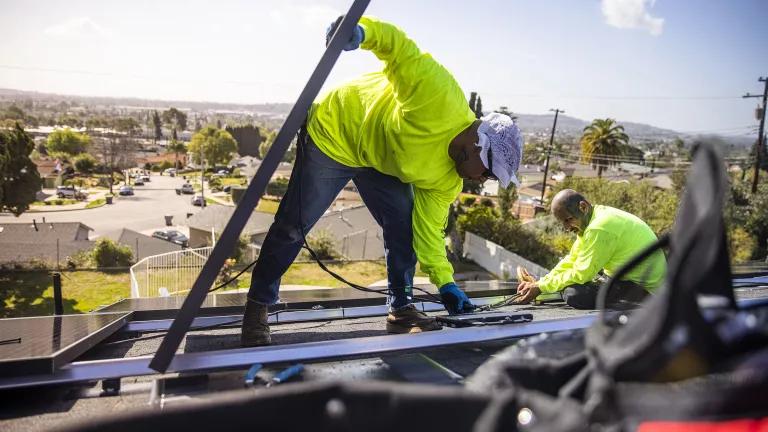California’s Rooftop Solar Net Metering Program
California is in the midst of seeking input from stakeholders, through a California Public Utilities Commission process, to evolve its approach to its net metering rooftop solar program in a manner that accounts for emerging needs and market trends.

Rooftop solar panel installation on a home in Southern California
Long a pioneer in the adoption and acceleration of solar power, California is in the midst of seeking input from stakeholders, through a California Public Utilities Commission (CPUC) process, to evolve its approach to its net metering rooftop solar program in a manner that accounts for emerging needs and market trends. There’s work to be done to ensure that, as we move forward, people of every income level share in the benefits of solar power and that rooftop solar continues to thrive. That’s how California continues to lead in creating the clean energy jobs of the future, confronting the existential environmental challenge of our time, and helping to build a more just and equitable society.
What, exactly, is net metering?
During long days of bright sunshine, rooftop solar panels often generate more electricity than a home will use. Net metering is a rate design intended to encourage more rooftop solar by enabling residential customers to essentially spin their electricity meter backward, creating credits they can then use when they need power from the grid at night. Under current net metering, these credits are worth the same retail rate as what the utilities charge for electricity consumed.
Net metering is a great way to expand the adoption of rooftop solar. California was one of the first states to adopt this type of program, and currently 35 other states have net metering programs. NRDC has been a leading and vocal advocate of net metering and other policies to advance rooftop solar in many of these states.
What’s been the result of California’s net metering program?
It’s been a huge success! Well over one million homes in California have rooftop solar—making it a national leader on solar. And as more customers installed rooftop solar systems, the amount of solar-generated energy increased dramatically, and the cost of installing the rooftop solar systems plummeted.
What’s wrong with that?
Nothing, at first. It worked precisely as designed. The only wrinkle has been that the rate design has not evolved to keep in line with the success of rooftop solar.
What does that mean?
The rates are set by the California Public Service Commission. Today’s rates for net metering were established when solar power was just beginning to take off, at a time when solar needed to be incentivized because of its high installation cost. Plus, back then, the grid needed more power at midday, so solar was more valuable. As more and more solar has come onto the grid, the value of power in the middle of the day has decreased. At the same time, the retail rates—and thus, the value of the net metering credits—have doubled or tripled. So today, utilities effectively pay rooftop solar users five times what that energy is worth in California.

Rooftop solar panels on homes in San Jose, California
What’s the harm of getting paid well for generating renewable energy?
In theory, nothing! But the policy didn’t anticipate the impact this would have on rates for those who can’t afford rooftop solar systems, don’t own their own homes, or otherwise haven’t installed solar equipment. The costs of maintaining the grid still have to be paid, but with the success of net metering, those costs have to be collected over the fewer and fewer kilowatt-hours sold. In other words, the costs are being passed along to customers without solar on their roofs.
The unintended result: People who haven’t installed rooftop solar systems are paying for the grid that all of us—including rooftop solar customers—need. We need stakeholders to come together to help ensure the continued growth of equitable and sustainable solar power in California.
Why are consumers shouldering those costs?
There are a lot of factors that have driven up rates in California, and there is no doubt that rates are too high. Right now, net metering is part of what’s driving them higher, but net metering can also be part of the solution to making the electric system fairer. That’s where the California Public Utilities Commission comes in. The commission sets the rates for electricity, including the electricity that comes from rooftop solar. And as part of that, they’re charged with looking at the financial impact on all residents, the costs of operating the power companies, and a host of additional factors. Bringing together all the stakeholders is key to finding the best solution.
How significant is the cost impact?
It can be substantial. California power companies are paying up to five times more to buy rooftop solar power than it would cost to buy and deliver the same electricity wholesale. In San Diego, for instance, these overpayments account for more than 15 cents on every dollar that households pay for electricity. For customers who don’t have rooftop solar systems, those extra costs can add between $60 and $200 to their annual bills.
Who gets the most benefits from the program?
Most of the benefits right now are going to higher-income customers. Across California, the lowest 40 percent of earners make up just 13 percent of rooftop solar customers. The rest are subsidizing higher-income customers who own rooftop solar systems. We need to fix this and make sure everyone benefits from clean energy.
How does this fit into California’s larger plan to tackle climate change?
California has committed to cutting greenhouse gas emissions to 40 percent below 1990 levels by 2030. That means shifting away from the fossil fuels that are driving the climate crisis, and toward cleaner, smarter ways to power our future. One way to do that is to get more clean power from the wind and sun. That’s why getting this program right is so important.
It also means cutting pollution from our vehicles and from our homes and buildings. To do that, we have to shift to electric cars and trucks, and to replace gas-burning stoves and water heaters with energy-efficient units powered by clean electricity. For that to pencil out, electricity rates must be affordable to all.
Aren’t you worried that you’re going to stunt the very growth in solar power you say you endorse?
No—to the contrary, we want to see the continued growth of sustainable, equitable solar power in California. That’s our mission.
NRDC is a strong proponent of expanding solar energy across the country and the world. We are advocating for its expansion and investment at the federal level. We have advocated for extending and expanding net metering and other solar support programs in states across the country. In California, we are also supporting a bill, alongside solar advocates, companies, and other environmental groups, that would help expedite permitting of new solar energy systems and reduce costs. And we are seeking out additional legislation that can build bridges with all stakeholders and advance shared clean energy goals.
We have an opportunity, and a responsibility, to confront the widening climate crisis and to do it equitably. Growing wind and solar energy in every state is imperative to doing that. Fortunately, the dramatic decline of the cost of solar energy allows us to sustain the growth of solar energy while reducing the burden for those who don’t have rooftop solar.
So, how do we fix the problem?
We don’t have to choose between climate action and an equitable society. The two go hand in hand. There can be no climate progress without climate justice.
As the California Public Utilities Commission evolves its net metering program, it is important that the commission’s plan increases access to solar, reduces the costs that have to get collected from non–rooftop solar customers, and ensures that the number of rooftop solar systems in California continues to increase sustainably. There are many ways to achieve these goals, and that’s why we are committed to working with all stakeholders to align our policy approach with emerging needs and market trends, as we build the clean energy economy of the future together.
For more information on NRDC’s clean energy advocacy, please see here.


